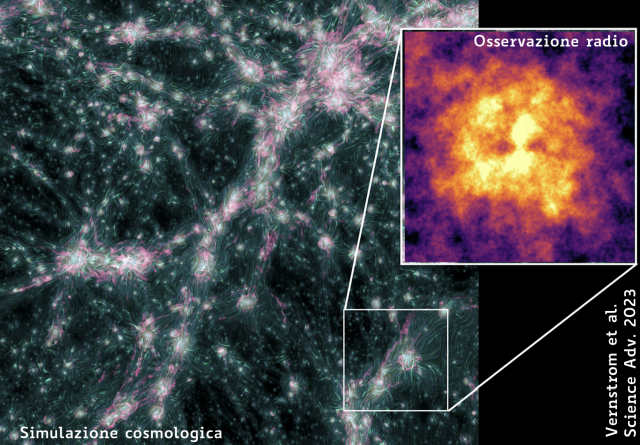Giant polarized shock waves shake the cosmic web of the universe
For the first time, scientists observed the undebatable traces of the cosmic magnetism that is generated, at the periphery of galaxy clusters and cosmic filaments, when massive masses of plasma come towards the cosmic web
Simulated image of the cosmic web that shows the large-scale distribution of the intergalactic magnetic field (green lines) and radio emission from plasma shock waves (purple colors) (Credits: J. West, D. Wittor & F. Vazza). The box instead shows the real radio emission, obtained by adding the maps of hundreds of thousands of objects. (Credits: T. Vernstrom et al., Sc. Adv.)
Science Advances recently published a study - led by astronomer Tessa Vernstrom of the University of Western Australia (UWA), in which astrophysicists from the University of Bologna and the INAF of Bologna collaborated - that shows, for the first time, the presence of radio signals produced by giant shock waves of plasma masses in the cosmic web. These are the first undebatable traces of cosmic magnetism generated on the outskirts of galaxy clusters: the largest structures in the universe. An event predicted for decades in numerical simulations, but never directly observed, so far.
"These shock waves accelerate relativistic electrons, which, spiraling in an external magnetic field, radiate energy in the radio band of the electromagnetic spectrum," explains Franco Vazza, professor at the "Augusto Righi" Department of Physics and Astronomy of the University of Bologna, associated with INAF and author of the numerical simulations used in the study. "The new observations mirror theoretical predictions very closely, and this gives us hope that we have actually revealed, for the first time, the signal of the magnetized plasma, swept by the shock waves of the cosmic web."
When observing the cosmos on the widest scale possible, matter appears as an intricate network of filaments and halos full of very hot and rarefied gas (plasma), separated by gigantic spaces extending millions of light years. This "spider web" structure of the cosmic web had already been predicted in the 1960s by the first computer-generated numerical models. In the 1980s, a series of observations confirmed it. Over the last few years, astronomers have then managed to map the cosmic web with deeper and more complete observations, which have produced new questions and enigmas.
One of the most relevant questions concerns the evolution of magnetic fields in the cosmic web and, precisely, the apparently empty spaces between one galaxy and another. Are there magnetic field lines in these "empty" regions? And if they exist, how do they influence the evolution of the cosmic web? These are questions that the global astrophysics community has been looking for answers to for several decades. Answers necessarily depart from the verification of the actual existence of these magnetic fields in the rarest regions of the universe, which, so far, had never been unequivocally obtained.
"Magnetic fields pervade the universe, from the scale of planets and stars to that of intergalactic space. However, we miss many fundamental aspects of magnetism on cosmological scales," explains Tessa Vernstrom. "When giant masses of plasma are accelerated towards the cosmic web - due to the gravity of the matter already present in the web - giant shock waves are generated which compress the intergalactic magnetic field lines. What we think we have finally observed for the first time it is precisely the signal of these compressed magnetic field lines".
This result comes after years of studies and observations. In 2020, the research team obtained promising results by adding hundreds of thousands of apparently empty images of the intergalactic fields between pairs of galaxies. However, scientists were unable to rule out, beyond a doubt, that those signals were generated by other celestial objects. The results now published in Science Advances overcome even the last doubts and show unequivocally the presence of polarized radio emissions coming from the filaments of the cosmic web.
"There are very few celestial sources capable of producing polarized radio emission on such large cosmic scales," confirms Christopher Riseley, astronomer of the "Augusto Righi" Department of Physics and Astronomy of the University of Bologna, INAF associate and co-author of the study. "The new observations produced for this study took into consideration the polarized part of the celestial radio emission only. This allowed us to exclude other possible sources of emission."
The scientists used data and maps from the Global Magneto-Ionic Medium Survey, the Planck Mission data archive, the Owens Valley Long Wavelength Array radio interferometer, and the Murchison Widefield Array, one of the most powerful radio telescopes on the planet (together with the European LOFAR) and "precursor" of the Square Kilometer Array (the most colossal astronomical observatory ever conceived, the construction of which has recently begun also thanks to the Italian collaboration, and whose "first light" is scheduled for 2029).
The numerical simulations - at the basis of the theoretical predictions of the polarized radio signal of the cosmic web - were produced by running the Enzo code on about two thousand processors at the CSCS calculation center in Lugano (Switzerland). This process was part of the MAGCOW research project, led by prof. Vazza and funded by the European Research Council. Christopher Riseley's research activity is, instead, supported by the European project DRANOEL.
The study is published in the journal Science Advances. Its title is "Polarized accretion shocks from the cosmic web". For the University of Bologna, Franco Vazza and Christopher Riseley from the "Augusto Righi" Department of Physics and Astronomy, both associated with INAF - National Institute of Astrophysics, participated.

